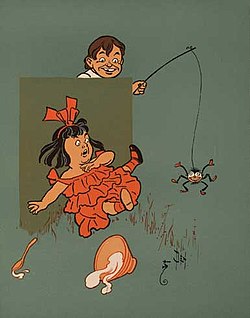Arachnophobia
This article needs additional citations for verification. (October 2007) |

Arachnophobia or arachnephobia (from the Greek: ἀράχνη, aráchnē, "spider" and φόβος, phóbos, "fear") is a specific phobia, the fear of spiders and other arachnids such as scorpions. It is a manifestation of zoophobia, among the most common of all phobias.[1] The reactions of arachnophobics are often irrational (though not all arachnophobics acknowledge this irrationality). People with arachnophobia tend to feel uneasy in any area they believe could harbor spiders or that has visible signs of their presence, such as webs. If arachnophobics see a spider, they may not enter the general vicinity until they have overcome the panic attack that is often associated with their phobia. Some people scream, cry, have trouble breathing, excess sweating or even heart trouble when they come in contact with an area near spiders or their webs. In some extreme cases, even a picture or a realistic drawing of a spider can also trigger fear. Arachnophobics may also be afraid if they are touched by or touch an object that feels like a spider.
The fear of spiders can be treated by any of the general techniques suggested for specific phobias. As with all phobias, the strength of the associations means the individual must not actively pursue the consequences, and outsiders should not in any way undermine and "play" with the phobia in the meantime.
An evolutionary reason for the phobias, such as arachnophobia, claustrophobia, fear of snakes or mice, etc. remains unresolved. One view, especially held in evolutionary psychology, is that the presence of venomous spiders led to the evolution of a fear of spiders or made acquisition of a fear of spiders especially easy. Like all traits, there is variability in the intensity of fears of spiders, and those with more intense fears are classified as phobic. Spiders, for instance, being relatively small, don’t fit the usual criterion for a threat in the animal kingdom where size is a factor, but nearly all species are venomous, and although rarely dangerous to humans, some species are dangerous. Arachnophobes will spare no effort to make sure that their whereabouts are spider-free, hence they would have had a reduced risk of being bitten in ancestral environments. Therefore, arachnophobes may possess a slight advantage over non-arachnophobes in terms of survival. However, this theory is undermined by the disproportional fear of spiders in comparison to other, potentially dangerous creatures[2] that were present during Homo sapiens environment of evolutionary adaptiveness. Studies with crickets have shown that a fear of spiders can develop before birth.[3]
The alternative view is that the dangers, such as from spiders, are overrated and not sufficient to influence evolution. Instead, inheriting phobias would have restrictive and debilitating effects upon survival, rather than being an aid. For some communities such as in Papua New Guinea and South America (except Chile, Colombia, Brazil, Uruguay, Argentina and Bolivia), spiders are included in traditional foods. This suggests arachnophobia may be a cultural, rather than genetic trait.
In Western societies as many as 55% of females and 18% of males are estimated to experience arachnophobia.[4]
[5] Arachnophobia is the most common of all the phobias, and a way of treating the disorder would be cognitive-behavioral therapy, or medications. Some medications someone with this phobia might take would include anti-anxiety medications or anti-depressants. Also, a therapist might choose to have the subject partake in what is called "Exposure Therapy" where the person is exposed to virtual spiders and then eventually live spiders little by little until they have overcome the phobia.
References
- ^ "The Fear Factor: Phobias" By Heather Hatfield, WebMD
- ^ Gerdes et al., 2009
- ^ "Fear of spiders can develop before birth". MSNBC. Feb. 18, 2010. Retrieved 19 February 2010.
{{cite news}}: Check date values in:|date=(help) - ^ Davey, 1992
- ^ Ohman, Arne, Mineka, Susan. “Fears, Phobias, and Preparedness: Toward an Evolved Module of Fear and Fear Learning.” Psychological Review. 2001. 108:3. pp. 483-522. June 28, 2008. http://instruct.uwo.ca/psychology/371g/Ohman2001.pdf
External links
- Stiemerling D. Analysis of a spider and monster phobia, Z. Psychosom Med Psychoanal. October–December;1973 (4):327-45. Template:De icon
- National Geographic: Fear of Spiders rooted in Evolution
